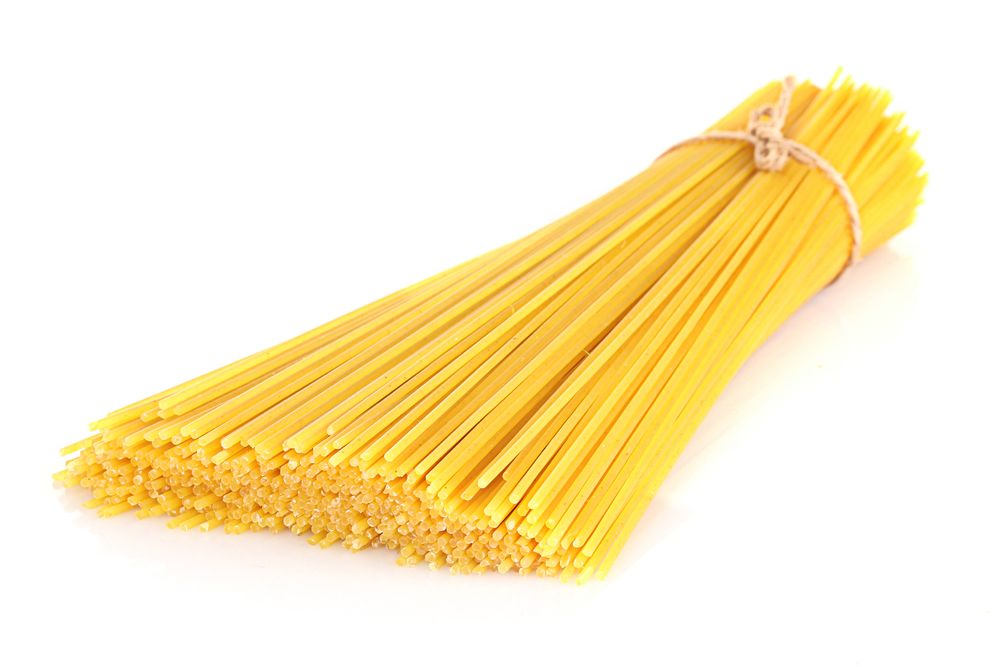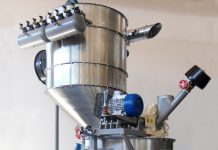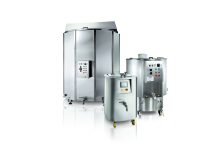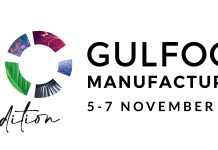The more advanced innovations in pasta manufacturing have been directed to optimize the drying process
The use of raw material with good characteristics represents the key step for producing pasta of high quality. Nevertheless, the whole production chain greatly affects this quality: in the last decades, considerable progress has been made in identifying some phenomena that take place during processing, particularly in drying. Infact, the more advanced innovations in pasta manufacturing have been directed to optimize this process. Drying is the elimination of a liquid, normally water, from a substance or a solid body: if the water is inside it, the methods of drying will depend on the body’s physical and chemical properties, in particular on the characteristics of the body at issue. This is the case that concerns drying pasta, in fact drying is the most difficult and critical step to control in the pasta production process. The objective of drying is to lower the moisture content of the pasta from approximately 31% to 12-13% so that the finished product will be hard, retain its shape, and store without spoiling. However, the essential prerequisite for the pasta is not only to be dry, but also to have been dried properly; this means that, besides being dry, pasta needs to be “stable”: its internal moisture content must be remaining uniform. Since the outside surface of the pasta dries more rapidly than the inside, moisture gradients develop across the surface to the interior of the pasta. If dried too quickly, the pasta will crack, giving the product a poor appearance and very low mechanical strength. On the contrary, if the pasta is dried too slowly, it tends to spoil or become mouldy during the drying process. When drying cycle has been successful, the pasta will be firm but also flexible enough so that it can bend to a considerable degree before breaking. So, the most significant physical states for pasta drying technology are the moisture and temperature of the air and the humidity and temperature of the product. Very briefly, drying pasta means modulating and properly controlling the evaporation of water from the product, using heat and ventilation. In general, the drying process can be realized by two different methods, that correspond to the plastic and elastic states of the product: the best results are obtained by applying a preliminary low drying temperature to reduce the pasta moisture, followed by a high drying temperature.
Plastic and elastic state of pasta
On leaving the die, pasta normally has a moisture content of approximately 31-32% and is in a “plastic state”. The dough in its plastic state is deformed by the action of the die and the shape obtained will not be altered when the pressure of the die has stopped. Pasta can then undergo even powerful drying without this causing any internal tension and the risk of damage; also the deformation suffered due to extraction of the water will be maintained. When, proceeding with drying, the product’s moisture content falls further(22-18%), the state of the pasta changes from plastic to elastic. In this new state the product’s behavior is totally different: pasta subjected to stress deforms, but tends to recover its original shape as soon as the stress stops. Besides causing deformation, stresses can then bring about tension inside the product: if the tension comes within the product’s specific limit of elasticity, it can be absorbed precisely by its own elasticity. These two different situations of the physical state of the product determine the subdivision of the process into the two fundamental phase, called pre-drying and drying; at the end, it is essential to stabilize the product.
Drying process
During the first phase, the moisture content of the product falls from 30-32% to 18-17%; the time this phase takes depends on a few variables: the temperature is the main. During pre-drying the water is extracted from the product with the highest rate. Also, this pre-drying technology makes it possible to gain different objectives: such as partial blockage of some enzyme activity and virtually total blockage of any product of fermentation; then it allows to uniform gluten distribution making possible the capacity of gluten to hold back the starch particles. Also, this pre-drying can decrease oxidation of the yellow pigments contained in the semolina and therefore give a brighter color of the dried product. Finally, this phase can provide a better shape stability and maintain the product’s capillarity, essential to redistribute the particles of water during the following steps of the process. The second step of drying must envisage alternating phases of water evaporation from the surface and of inside redistribution. Right now, ambient temperature and humidity normally decrease, clearly complying with the current temperature and moisture of the product. The speed of this phase is inevitably less than that of pre-drying, because of the structure of the product, passed on to the elastic state, has become more rigid, capillary action has decreased and so the migration of the remaining particles of water is slower. Putting these considerations into practice, there is the need to alternate phases of drying with phases of “re-hydration”. Thus means a long time, differently from the corresponding procedures implemented during pre-drying. The main aim is to avoid that the outside surface of the pasta dries up too much and too quickly, a result obtained by keeping the three components in functional balance: air temperature, air humidity, and ventilation flows.
Innovation technology and benefits
In the last decades, the so-called high-temperature (HT) drying technology has been widely applied by pasta manufacturers. With respect to the low-temperature drying process, drying carried out at high temperatures leads to an improvement in pasta color and firmness, lower cooking loss with higher cooked weight and less stickiness and also a decrease in bulkiness and adhesiveness. In order, the level of starch damage was lower in HT-dried pasta, probably due to lower activity of amylolytic enzymes, so it is reasonable to assume that an increased thermo-stability of starch has a positive influence on the cooking properties of pasta. Regarding the quality of the raw material, it could be considered a non critical parameter if pasta was dried at high temperature and it was possible to obtain a good cooking quality pasta also using pasta with low gluten content semolina. Furthermore, there is a reduction in microorganisms as total count and shorter drying times as well as the increased plant productivity. In conclusion,the quality characteristics of pasta during cooking improved as drying temperature increased. However, in order not to lose the technological advantages of HT in pasta drying is important keeping heat-damage under control, in particular using proper tools, such as thermo-resistances to measure temperature and psychrometer, an instrument which allows to determine the relative humidity, or by using capacitive resistive probes to control the relative humidity and temperature, because these two parameters, as mentioned, are crucially to achieve this process.
by Arianna Roda, Istituto di Enologia e Ingegneria Agro-alimentare, Università Cattolica del Sacro Cuore – Piacenza
References
• Alamprese et al., “Role of pasteurization heat treatments on rheological and protein structural characteristics of fresh egg pasta”, Eur. Food Res. Technol., 221, 759-767, 2005.
• Anese et al., “Effects of drying processing on the Maillard reaction in pasta”, Food Research International, 32, 193-199, 1999
• Baiano et al., “Influence of drying temperature on the spaghetti cooking quality”, Journal of Food Engineering, 76, 341–347, 2006
• De Cindio et al., “Modelling of drying for high quality pasta production”, Department of Chemical Engineering and Materials, 3rd International Symposium on Food Rheology and Structure
• De Noni and Pagani, “Cooking properties and heat damage of dried pasta as infl uenced by raw material characteristics and processing conditions”, Food Science and Nutrition, 50, 465-472, 2010
• Guler et al., “Effects of industrial pasta drying temperatures on starch properties and pasta quality”, Food Research International, 35, 421–427, 2002
• Lamacchia et al., “Changes in pasta proteins induced by drying cycles and their relationship to cooking behavior”, Journal of Cereal Science, 46, 58–63, 2007
• Mariotti et al., “Infl uence of the Heating Rate on the Pasting Properties of Various Flours”, Department of Food Science and Microbiology, 57, 564-572, 2005
• Singh and MacRitchie, “Changes in proteins induced by heating gluten dispersions at high temperature”, Journal of Cereal Science, 39, 297–301, 2004
• Wyland and D’Appolonia, “Infl uence of drying temperature and farina blending on spaghetti quality”, Department of Cereal Chemistry and Technology, 59, 199-201, 2003
• www.professionalpasta.it






Olay
Cool article, It was inspiring.
Hi,
Great article. We are a very small pasta producer in Louisville, KY. However, a big stumbling block for us has been drying. We control a whole room, but struggle with the temperature of drying and humidity balance as your article suggest. We have tested over 4 years, and finally found our drying recipe for each shape. Any other suggested reading on this you would suggest?
Kind regards
Linnea
Cavallo Nero Pasta
I occasionally cater events and have been on the verge of purchasing a small commercial pasta maker such as the Dolly II from XXXXX. This machine, as small as it is, can make far more pasta in a day than needed for any event I may be doing in a week. I would like to find a small commercial dryer unit (if such exists) or plans to build and run my own. I am NOT interested in mass production. I make very limited runs often of an experimental nature changing one one quantity at a time in the recipie until I get exactly what I want. Does anyone viewing these posts know of such a machine or plans? Thanks in advance.
I occasionally cater events and have been on the verge of purchasing a small commercial pasta maker such as the Dolly II. This machine, as small as it is, can make far more pasta in a day than needed for any event I may be doing in a week. I would like to find a small commercial dryer unit (if such exists) or plans to build and run my own. I am NOT interested in mass production. I make very limited runs often of an experimental nature changing one one quantity at a time in the recipie until I get exactly what I want. Does anyone viewing these posts know of such a machine or plans? Thanks in advance.
Comments are closed.